The past two years have had many of us not only dreaming of our next vacations, but also looking to more expansive and extraordinary territories—to landscapes of memory, emotion, spirituality, and imagination. We’ve been scouting locations for more clarity, for metaphysical understanding, for what is most important.
Brazilian artist Marina Perez Simão outlines these landscapes in her paintings, gliding between figuration and abstraction, showing us colors and shapes we understand so that we can begin mapping out realms beyond our grasp.
Her luscious streams and swipes of pigment sometimes gather to create a faintly recognizable detail—a sea wave; a heavy red sun—with their velvety swoops partitioning out a path for the eyes, like the curtains that frame paintings in the Baroque churches of her native Minas Gerais, Brazil.
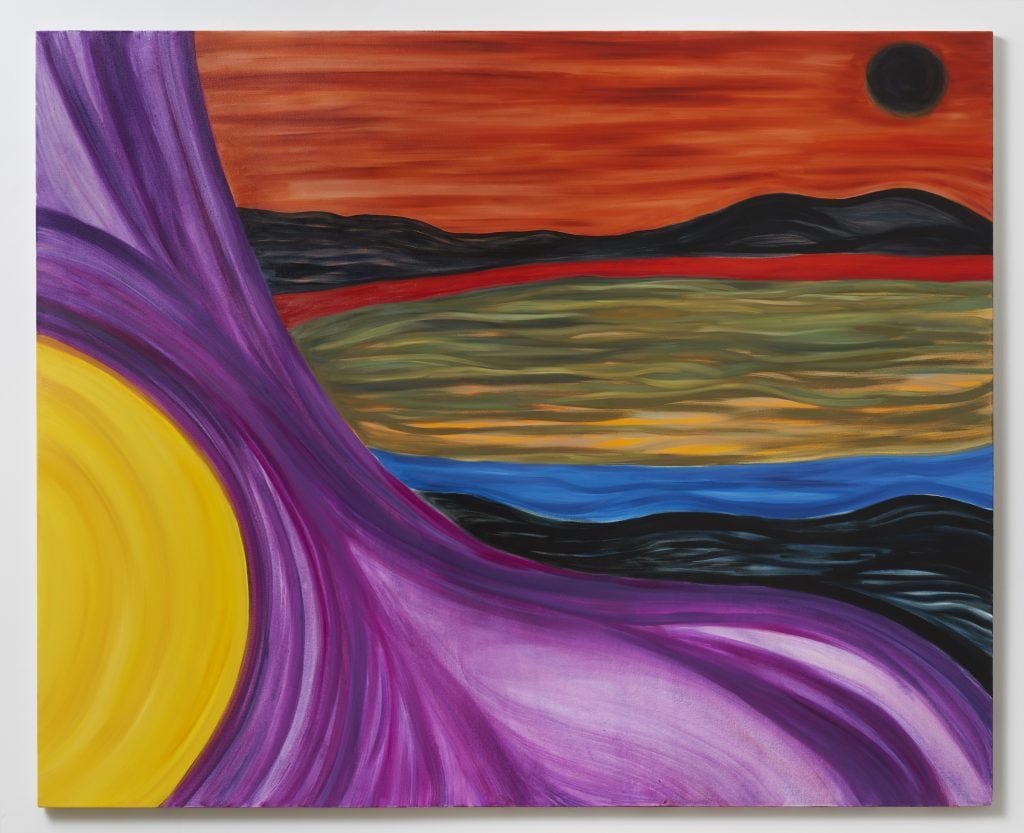
Marina Perez Simão, Untitled, 2021. © Marina Perez Simão Courtesy of the artist, Mendes Wood DM, and Pace Gallery.
Simão paints several works at the same time. “They don’t look too much alike, but they share the same internal logic,” the artist said from her São Paulo home. “I often [include] more than one horizon. I break the composition [for] a change of state, in a way—a promise of something beyond the painting.”
“Marina’s work attempts to open up portals of wonder in the viewer, making them imagine other universes where the limits of reality don’t hold,” said Diana Campbell, who curated “Observatory,” Simão’s recent exhibition at the Sifang Art Museum in Nanjing, China.
With the Steven Holl-designed museum primarily comprised of oblique walls, the show was constellation of sorts, pulling visitors into a third dimension. “We tried to treat the building like an observatory, where the paintings were almost like windows into another world,” Campbell said.
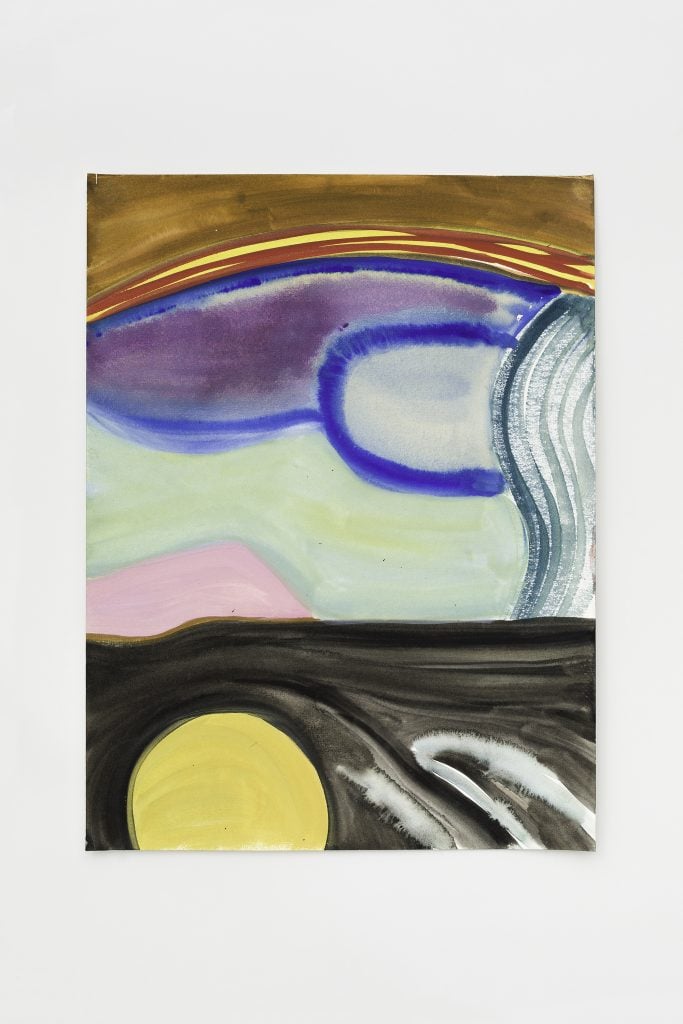
Marina Perez Simão, Untitled, 2021. © Marina Perez Simão Courtesy of the artist, Mendes Wood DM, and Pace Gallery.
Born in 1980 in Vitória, Brazil, Simão was brought up between Minas Gerais and Rio de Janeiro. The natural world’s relentless incursions into the cities’ urban landscapes left a strong impression on the budding artist. Originally she attended law school, taking painting and ceramics classes on the side. Then, art took over.
Simão enrolled at Beaux-Arts de Paris, studying under Brazilian sculptor Solange Pessoa and staying in Paris for seven years. There, she met fellow student Pedro Mendes before he started the São Paulo–based Mendes Wood DM. Simão was the gallery’s first artist when it opened in 2010 (it has since grown internationally, with locations in Brussels and New York).
Last spring, she made her solo debut at Pace Gallery in New York with “Tudo é e não é” (Portuguese for “Everything is and is not”). The exhibition was named after a line from Brazilian writer João Guimarães Rosa’s experimental 1956 novel Grande Sertão: Veredas (The Devil to Pay in the Backlands), which explores the human mind by way of Minas Gerais.
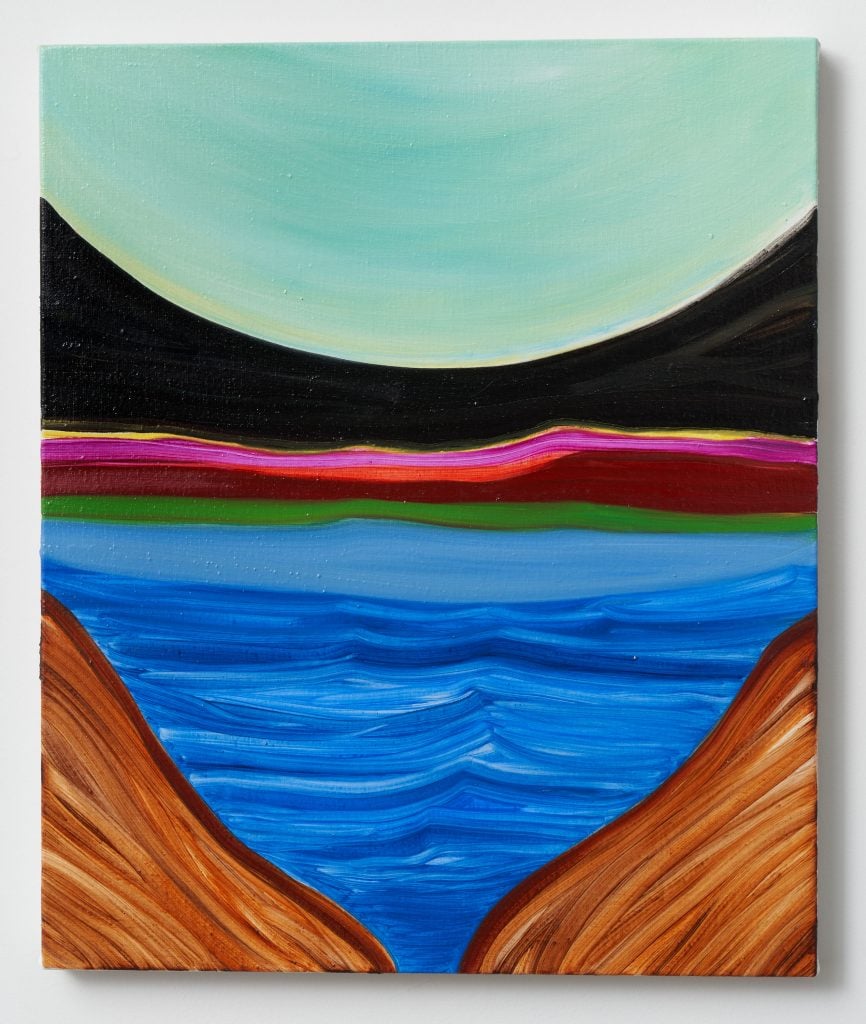
Marina Perez Simão, Untitled, 2021. © Marina Perez Simão Courtesy of the artist, Mendes Wood DM, and Pace Gallery.
Simão painted its 23 untitled canvases nearly a year into quarantine in São Paulo. They document a desire for, rather than a direct view of, some of her most restorative settings: the endless blues of the open Atlantic Ocean; the turbulent skies in Rio’s rainy season; the verdant hills of Minas Gerais, both before and after the thick morning fog.
“Her imagination manifests in her paintings, and her paintings manifest in her imagination. It’s very evasive, mysterious,” Mendes said.
As Simão wrote in her painting notes, “I need to surprise myself. I need to have the feeling of ignorance: What is this? Where is this?”
Each element of her compositions is, at minimum, a presence and its opposite: a light source can be either a sun or a moon; a foreground can just as easily be a background; a liquid may well be a solid, too.
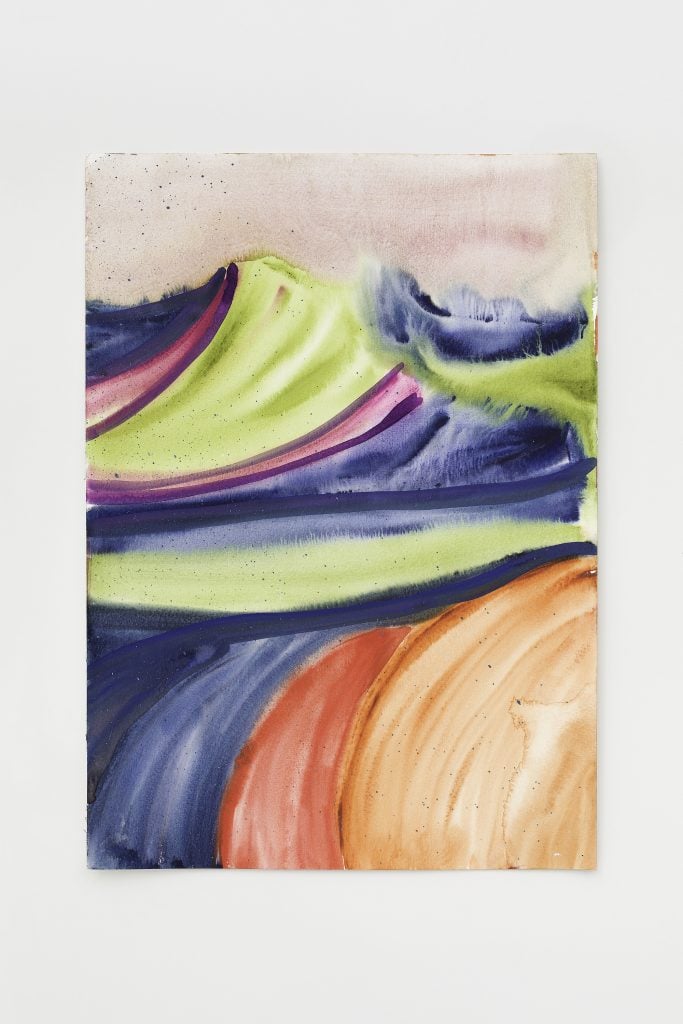
Marina Perez Simão, Untitled, 2021. © Marina Perez Simão Courtesy of the artist, Mendes Wood DM, and Pace Gallery.
She starts each painting as a study in her sketchbook, then turns it into a watercolor, moving her hand in long, confident strokes to the edges of her canvas. “I really don’t like hesitation in painting,” said the artist. “I like direct gesture—and for that, I need to be prepared.”
“She’s been working on the same paintings for 15 years, since she started studying,” said Mendes Wood DM associate director Matheus Yehudi. “You can see it [in] her older work, her writing, her studies; to visit her studio is to have a master class in art, physics, astronomy.”
“The work has been developed in her practice and especially in her mind. I would define her mind as a kaleidoscope, and it’s only now that she has all the information she’s needed [to make these paintings].”
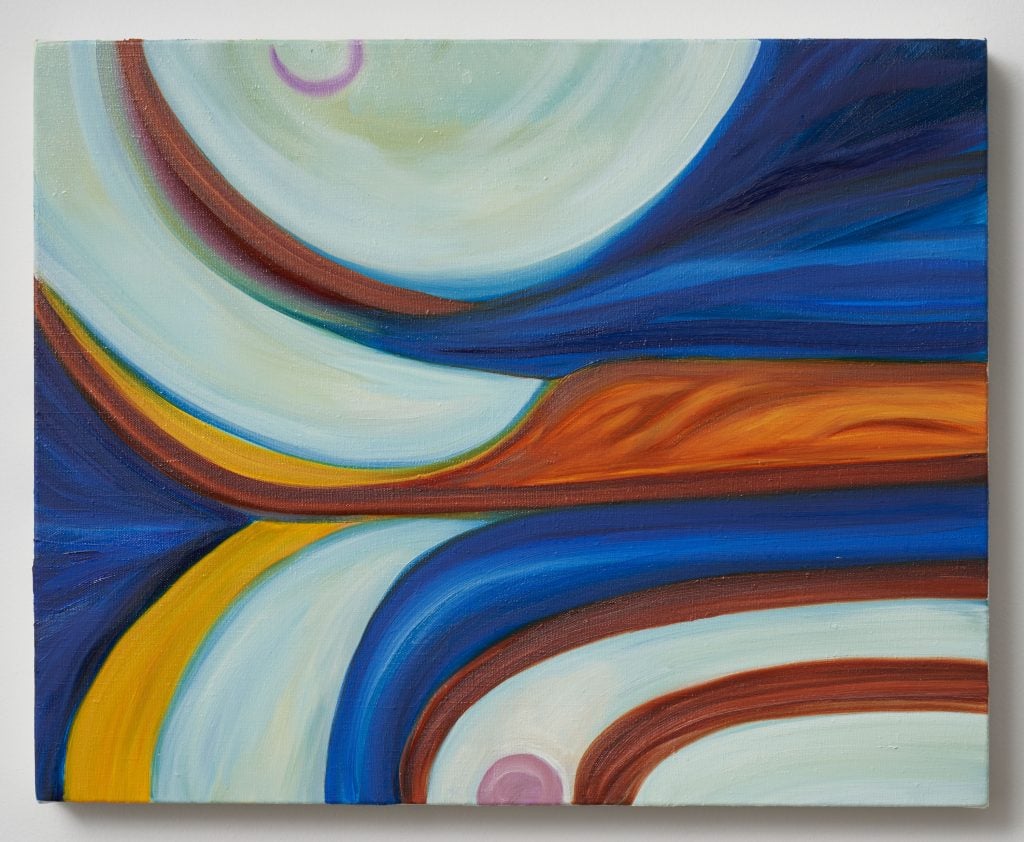
Marina Perez Simão, Untitled, 2021. © Marina Perez Simão Courtesy of the artist, Mendes Wood DM, and Pace Gallery.
Beyond her loyal collector base in Brazil, they can be found in the collections of art institutions around the world, from the Musée d’Art Moderne et Contemporain (MAMC) in Saint-Étienne, France, to the Samdani Art Foundation in Dhaka, Bangladesh, to the Long Museum in Shanghai, Chongqing, and Pudong, to the Dallas Museum of Art.
Meanwhile, the universal lockdowns seem to have given Simão’s colorful, spiritual vistas a recent surge in popularity: She has shown in three separate Pace Gallery shows in the past 18 months—in Geneva, New York City, and East Hampton.
“Marina’s work has an instant appeal given her mastery of color and form,” said Pace Gallery vice president Samanthe Rubell. “Her use of light combined with her inherent playfulness make both her realized and imagined landscapes transcendental.”
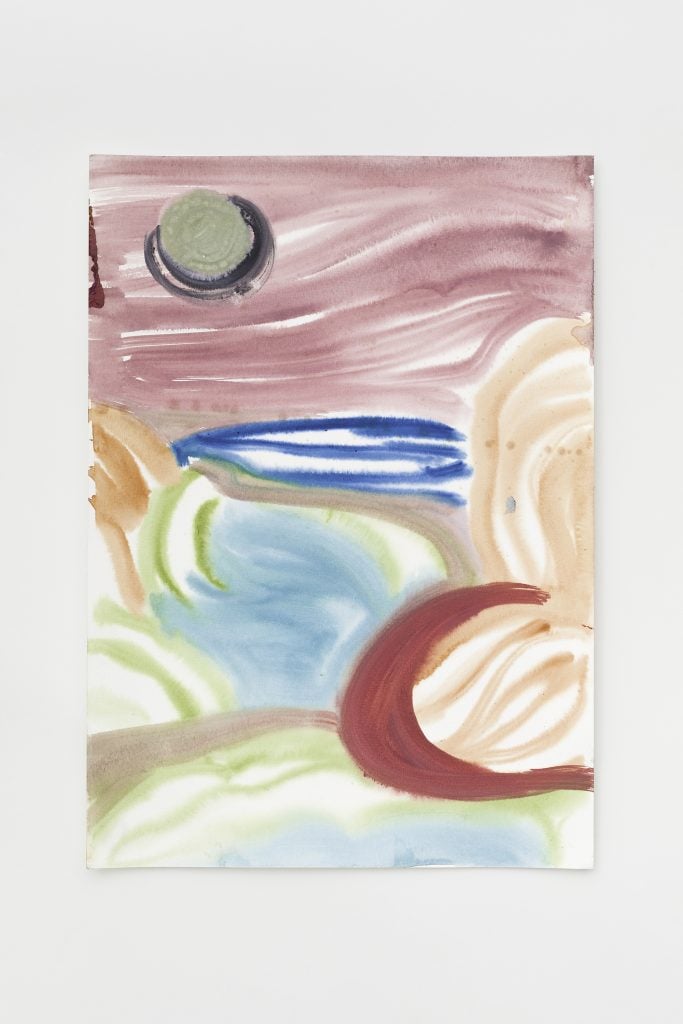
Marina Perez Simão, Untitled, 2021. © Marina Perez Simão Courtesy of the artist, Mendes Wood DM, and Pace Gallery.
“Her approach to the landscape genre, which is historically rich in Brazil, can be aligned with the art of Tarsila do Amaral, José Pancetti, Roberto Burle Marx, and Tomie Ohtake. However, Marina’s investigation of painting’s interplay with memory and literature imbues her work with a new, conceptual dimension that makes her vision a singular one.”
The artist, whose pieces now range between $30,000 and $100,000, has another major presentation set to open this fall at Pace’s new London outpost. It will coincide with the publication of monographs from Circle Books and Rizzoli. Though, as Yehudi said, “She’s not a moment.”
In this moment, however, while audiences navigate an increasingly chaotic world, Simão’s paintings are resonating at a much deeper level. As Mendes said, “The works allow you to travel to a temporary state of consciousness where you can get outside of yourself and into the beauty of her fictional worlds.” And right now, perhaps that is simply what everyone needs.












